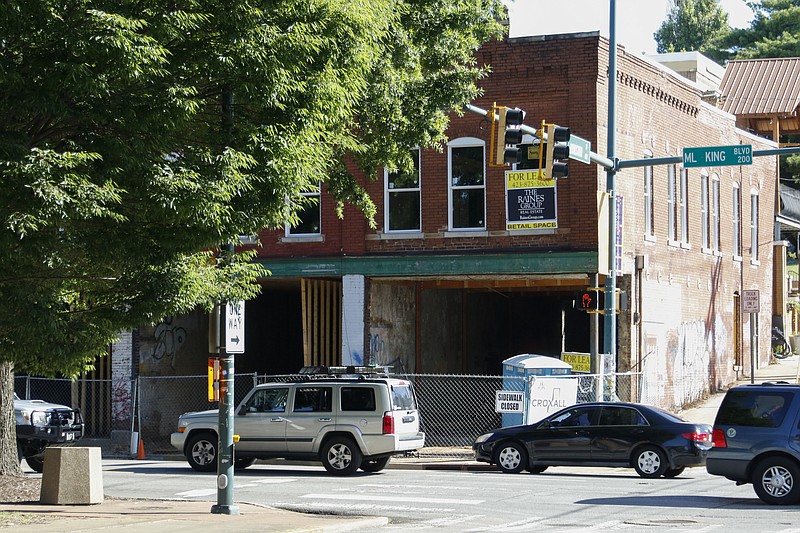What do you think?
Take a survey on the future of Martin Luther King Jr. Boulevard, visit connect.chattanooga.gov/mlkblvd/.
The city of Chattanooga would like to put Martin Luther King Jr. Boulevard on a "road diet."
The idea is to "improve safety for all people traveling through the corridor and to create a welcoming public space," according to an online survey the city - in partnership with the Benwood Foundation - wants residents to take.
If you read between the lines and see the words "bike lanes," go to the head of the class. Bike lanes, as part of a reduction in lanes from four to three (the third being a turn lane), are among the options under consideration. The city, after all, has a $1.4 million federally funded Congestion and Mitigation Air Quality grant in part to pay for a bike network throughout the city and support other safe streets projects.
Construction of whatever option is chosen - in the portion of M.L. King from Georgia Avenue to Palmetto Street - is scheduled for the spring of 2017.
However, we see a number of problems in converting four lanes into three, essentially two lanes, for the heavy traffic heading out the east-west corridor at the end of the work day.
Among them:
* It would create a bottleneck at the corner of M.L. King and Georgia Avenue, with two lanes coming east from the Chestnut, Broad and Market Street corridors and merging into one at Georgia Avenue.
* It would distribute more traffic to the residential-heavier Eighth and 10th streets, canceling the safety factor planners foresee with the changes.
* It would increase eastbound traffic on Interstate 24, which now has bumper-to-bumper traffic on a good day from about 4 p.m. to about 6:30 p.m.
* It would greatly slow drivers on north-south streets without traffic signals from getting onto M.L. King creating an especially perilous situation as cars back up the hill toward Eighth Street.
* It would make parallel parking on M.L. King next to impossible during the street's busiest hours, defeating the purpose to give the businesses along the corridor more exposure and a reason for stopping. And if it distributes drivers to other thoroughfares, isn't that defeating the same purpose?
* It would create a bike lane where bicyclers are rarely seen, despite the encouragement from past Street Smarts Safe Cycling classes at Outdoor Chattanooga for cyclers "to take possession" of the main lane of traffic.
In the spring, a presentation given to M.L. King Boulevard stakeholders offered two options for the portion of the street from Georgia Avenue to Palmetto Street. It did not indicate how traffic in the soon-to-be-renovated block between Miller Park and Miller Plaza would handle the narrowing of traffic.
One alternative offered reducing, or "right-sizing," four 10-foot lanes to three 10-foot lanes, the third being the turn lane. On either side of the traffic lanes were two 5-foot bike lanes and the parking lanes already in place. The slides accompanying the presentation did not show a replication of the hazardous, unattractive bike curbs that were erected on Broad Street last year.
"The most classic road diet" - yes, those words were used - "converts four lanes of traffic into three lanes, one in each direction, plus a left-turn lane in the middle," information on a presentation slide said. "By eliminating one full car lane, the '4-to-3' diet also leaves room for bike lanes on both sides of the street."
The other alternative involved reducing four 10-foot lanes to two 15-foot lanes and a 10-foot turn lane, plus the parking already in place. Bicycles, ostensibly, would either "take possession" of the traffic lanes or pedal along the side of the wider lanes.
The presentation also included a traffic analysis, based on the city's study of North Market Street, which already has been narrowed from two lanes in each direction to one lane plus a bike lane from Frazier Avenue to the Chattanooga High Center for Creative Arts.
The analysis indicated the M.L. King road "diet" would reduce speed 10 percent, reduce crashes 24 percent and add 73 seconds to a typical commute at the time of peak flow.
The online survey pictures a third alternative of no change in the traffic lanes but does not caption it as an option. However, the survey does allow respondents to select that option.
While we are cognizant of the increase in pedestrian traffic and some increase in bike traffic from the larger presence of the University of Tennessee at Chattanooga in the M.L. King neighborhood, and we're delighted that M.L. King Boulevard is becoming more of a retail corridor once again, we don't feel such a valuable east-west corridor should be reduced to one lane per direction (with a turn lane).
If its implementation wouldn't further clog I-24 or increase outbound traffic in nearby residential neighborhoods, we would be more sympathetic. But we believe whatever increase it might offer in safety along M.L. King would be lost in the loss on safety of additional outbound routes.
We hope others who use the corridor - no matter what their opinion is - will let the city know how they feel.
